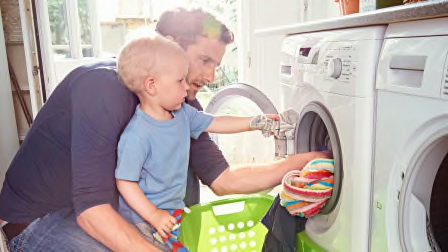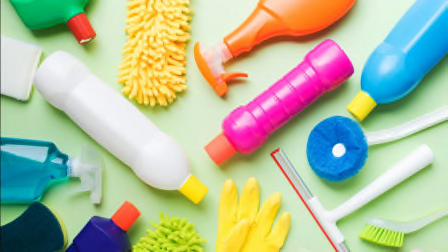Cleaning Secrets for Every Room
Easy ways to remove grit, grime, and germs in a safe, healthy way

More than two years into the pandemic, you may be a little weary of housecleaning chores. Some items—hello, stovetop!—are getting grubbier faster because we’re using them so much during the extended at-home stay. And many of us are scrubbing and disinfecting daily in an effort to keep COVID-19 at bay.
Well, step away from the spray cleaner, at least for a bit. “There is no evidence that cleaning more frequently prevents you from getting COVID-19,” says James H. Dickerson, PhD, chief scientific officer at Consumer Reports.
Earlier in the pandemic, some studies did suggest that the coronavirus could live on hard surfaces for days, even weeks. But most experts now agree that contact with a doorknob an infected person has touched presents no significant risk.
As Emanuel Goldman, PhD, a microbiologist at Rutgers University, says, “The reason there was a big push about transmission on surfaces was due to experiments in highly controlled environments not related to the real world.” In addition, it’s unlikely the form of coronavirus found on surfaces in most studies—viral RNA—is infectious, he says, calling it “the corpse of the virus.” Transmission generally occurs, we now know, through close contact with an infected person or via small airborne particles.
Wipe away food bits in the door gasket with a sponge to maintain a seal and keep cold air in.
Cast Out Kitchen Grime
The Challenge
Kitchens are among a home’s germiest spots, says Donald Schaffner, PhD, a Rutgers University professor of food microbiology. And with many of us eating our three squares at home day in and day out, food-prep grunge builds up fast on appliances and counters.
Top Tools
Sponge, baking soda, soft cloth, disinfectant cleanser, dish soap, abrasive cleaner (either gel or spray), glass cleaner or stainless steel polish.
Dirt-Busters
Remove smudges from appliance exteriors with a cleaning and polishing product made for stainless steel (if you have that finish) or just a damp cloth for other materials.
Wipe off food and grease from gas stovetops with a scrub pad and hot, soapy water after meal prep. The same should help inside the oven. There, cover tough stains with a wet cloth, let it sit a bit, and then hit them with the scrub pad and soapy water again.
For badly stained burner covers and grates, leave them overnight in a sealable plastic bag with one-fourth cup of ammonia so you can easily wipe them clean the next day. (Ventilate when using ammonia.)
Really need a deep clean? While some ovens have lower-temperature self-cleaning modes, high-temperature self-cleaning is the most effective, says Tara Casaregola, who oversees CR’s range tests.
To keep odors and gunk in your fridge at bay, go over plastic surfaces regularly with a sponge dipped in a cup of baking soda mixed with a quart of water. (An open box of baking soda in the fridge helps odor-proof further.) Wipe the door gasket with a damp sponge or cloth to maintain a good seal and keep the cold air in.
Smelly dishwasher? Pull out any food bits you see at the bottom, and rinse the filter as needed. You can also remove the spray arms and poke out any food that’s stuck in the holes with a toothpick.
Put condensation to work for microwave cleaning. Pop a bowl of water mixed with a quarter-cup of lemon juice inside and run the unit on high for a minute, then wipe. If caked-on food won’t budge, scrape it off with an old credit card. (But avoid the window.) This works in ovens, too.
For food particles and grease residue on sinks, check with the manufacturer for abrasive cleaners that won’t scratch, advises Brian Sansoni, senior vice president at the American Cleaning Institute. “In general, liquid, spray, and gel cleansers are less abrasive than powders,” he says.
With countertops, “care isn’t one-size-fits-all,” says John Galeotafiore, director of product testing at CR. So follow the manufacturer’s advice for cleaning yours. For instance, an end-of-day sweep with a damp cloth may be all you need for quartz, while a soft cloth or sponge dipped in dish liquid and water works for granite, laminate, and butcher block.
In general, skip scrubber sponges on counters, Dickerson says. “It can score them, leaving crevices and cracks where bacteria can get in and reside,” he says.
Germ Warfare
If someone at home has COVID-19, going over high-touch areas like countertops and fridge handles with a soapy sponge will wash away virus particles, Goldman says, but you can also use a coronavirus-killing disinfectant. Otherwise, attend to areas where high levels of microbes are common: sponges and sink drains.
“When there’s moisture and food, bacteria can multiply,” Schaffner says. So at least weekly, use a scrub brush to clear the sink drain of food particles and grime, then spray it with a household disinfectant. Throw dirty sponges in the dishwasher with a drying cycle, or microwave for a minute with a bit of water in a dish. The Department of Agriculture found these to be the best methods for killing foodborne bacteria.
Clean, then disinfect surfaces and items that have come into contact with raw meat or eggs, says Marshall (think countertops, handles, sinks). Cleaning away visible dirt first with soap and water will enhance disinfectant effectiveness. Mop up food spills in the fridge right away. You may also want to swab the inner surfaces regularly with soap and water or a disinfectant. And give grubby shelves and bins a warm water and soap bath in the sink, says Larry Ciufo, CR’s test engineer for refrigerators.
Clean or replace filters in vacuums and other machines to keep them working properly.
Keep Filters Debris-Free
The Challenge
Filters may be all too easy to overlook, but dirty ones can affect a device’s performance. With vacuums, for instance, especially bagless models, a blocked filter may reduce suction or spew dust back into the air.
Top Tools
Vacuum, running water, dish soap, new filters as needed.
Dirt-Busters
For air conditioners, air purifiers, dehumidifiers, and vacuums, you can usually hand-wash filters with water and mild soap, letting them dry fully before reinserting.
Wash window air conditioner filters monthly during times of heavy use. Replace disposable HVAC system filters every one to three months. (Washable filters have performed poorly in CR tests.) For air purifiers, follow the owner’s manual; filter replacement intervals vary widely. Wash your dehumidifier filter a few times a month when humidity is high, and buy a new one if you spot mildew or mold. Follow your owner’s manual for vacuum filters, because the advice varies depending on the model.
For water filters and refrigerator filters, which help remove lead and other contaminants from household water, check your owner’s manual for washing and replacement schedules.
Give your manual-clean dishwasher filter (found in most modern models) a weekly sniff test, and if it’s unpleasant, rinse the filter in your sink.
If you have an over-the-range microwave, periodically remove the mesh filter from the underside of the appliance, soak it in soap and water, rinse and let dry thoroughly, then pop it back in. Cooking a lot? Do this at least monthly to get rid of the grease from the range below.
Germ Warfare
HEPA filters for air purifiers can capture respiratory particles that carry most airborne viruses—including the coronavirus—and bacteria. Joseph Allen, DSc, an associate professor of exposure assessment science at the Harvard T.H. Chan School of Public Health, recommends placing a portable purifier in the bedroom of a household member with COVID-19.
But take care changing the filter and cleaning the device. Wear gloves and a mask, and take the entire machine outside. Clean and wipe the exterior with a disinfectant. Then remove the filter and dispose of it in a sealed bag. If your air purifier has a fabric prefilter—an additional way to trap particles—wash it.
Spray a bleach solution on shower doors and leave it for 30 minutes.
Make Busy Bathrooms Sparkle
The Challenge
Soap scum and mildew in and around the tub and shower, and persistent stains in the toilet.
Top Tools
Bathroom cleaner (this usually contains nonchlorine bleach), clean sponge, disinfectant or bleach, powder cleanser, old toothbrush, toilet brush.
Dirt-Busters
Crack a window or run an exhaust fan during and after showers, and wipe down tile walls and porcelain afterward to help prevent the moisture buildup that can lead to mildew. But if you’ve already got mildew or soap scum, spray on a solution of one part bleach to four parts water, let it sit for 30 minutes, wipe with a sponge, and finish with a water rinse. For hard-to-clean areas like shower door tracks, an old toothbrush can work magic. Dampen the bristles and brush away muck. Dipped in diluted bleach, that toothbrush can also do wonders on discolored grout.
For the toilet, brush the bowl weekly with a disinfectant cleanser to help remove minor stains and reddish-brown hard-water deposits. For hard-water spots that persist, a calcium, lime, and rust remover such as CLR should leave the bowl sparkling. Clean with it monthly to help prevent stains from reappearing.
Germ Warfare
Wiping bathroom surfaces with a soapy sponge should eliminate most germs. But if someone at home has been diagnosed with COVID-19, it’s wise to clean and disinfect the bathroom and other shared surfaces, Allen says.
For large surfaces, use a non-alcohol disinfectant, one that’s bleach- or hydrogen-based. Alcohol-based products are useful for disinfecting small objects but may dry before they can reach full effectiveness on large surfaces, notes Gregory Schrank, MD, an infectious disease specialist at the University of Maryland School of Medicine. For toilets, “the handle is the main part to focus on, but consider less obvious areas, like around the toilet seat and the lid, that might get touched a lot, too,” says Brian Sansoni, senior vice president at the American Cleaning Institute.
Cover each blade with a pillowcase, then pull it off along with any debris.
Tackle Dirty Floors and Ceiling Fans
The Challenge
All that household dirt and dust we’re generating these days typically ends up on floors and carpets, as well as on hard-to-reach ceiling fans.
Top Tools
Vacuum, pillowcase or ceiling fan duster, dust rags, carpet cleaner, steam mop.
Dirt-Busters
Do household dusting first (including ceiling fans), Sansoni says, so that dust and dirt don’t fall on a freshly vacuumed floor. And make sure that vacuuming devices are working well by regularly emptying their bins and cleaning filters as recommended.
For bare floors, a stick vac may be all you need, says Frank Rizzi, who conducts Consumer Reports’ vacuum tests. For carpets, CR’s tests have found that uprights are best because the weight of the device sits atop the brush head, pushing it down into the pile so it sucks up more debris.
Got stains? A carpet cleaner (hardware stores rent them) can remove the grime even the best vacuums can’t get at. Steam mops are ideal for deep-cleaning laminate, tile, and vinyl floors, but they can damage wood. With wood, different stains call for different solutions. For instance, scuff marks on wood floors sealed with urethane or polyurethane may give way if rubbed with a tennis ball or clean eraser.
As for those dusty ceiling fan blades, simply slip a pillowcase over one blade at a time, and then pull it and the dust right off. Wipe blades and housing with a damp cloth and an all-purpose cleaner. Dry everything thoroughly; damp blades attract dust.
Germ Warfare
If germs are a concern (say, someone has vomited on the floor or carpeting), it’s best to look at the manufacturer’s advice on disinfectant use before dabbing some on the area.
That said, a diluted solution of bleach and water is generally safe for laminate or vinyl, according to Bill Carroll, PhD, an adjunct professor of chemistry at Indiana University. A disinfectant product with quaternary ammonium (such as Lysol) should be safe for wood floors, but test it in an inconspicuous spot first. Wipe the area with a damp cloth afterward, and dry thoroughly. Otherwise, the disinfectant may leave a residue behind.
Use the right type and amount of detergent to minimize residue in your washer.
Freshen Your Washer and Dryer
The Challenge
Wrangling soap scum and the moisture that can lead to mold growth along with the unpleasant smell that often occurs with front-loading washers. For dryers, it’s curbing lint, which can be a fire hazard, slow drying, and hike utility bills.
Top Tools
Bleach, cotton ball, rubbing alcohol, duct lint brush.
Dirt-Busters
To make your washer less mold-friendly, move washed clothing to the dryer right away, and leave the door and detergent dispenser slightly ajar between loads, as long as kids and pets can’t get to it.
Use the right type and amount of laundry detergent to minimize residue like soap scum. Some are too sudsy for high-efficiency washers like front-loaders, so choose those labeled “HE” or for “all washers.”
And while it may seem odd to wash a washing machine, run the tub-clean or sanitize cycle—or simply a hot-water cycle with a washer cleaner containing bleach—regularly (some brands say monthly or every 50 loads) to help keep it odor-free and performing well.
For the dryer, clean the lint filter after every load. To reduce the risk of a fire caused by lint buildup, periodically remove lint from the duct in the back of the appliance. If you have access to the dryer vent outside your home, check it while you’re drying a load. You should feel air coming out. If you don’t, you may need to disconnect the duct from the dryer and clean it out (or you can call a professional to clean it for you).
If your dryer has moisture sensors, which shut the appliance off when clothes are dry, keep them working well by cleaning them with a cotton ball dampened with rubbing alcohol every few months, or anytime the auto-dry cycle seems to be malfunctioning.
Germ Warfare
If a household member has COVID-19 or another infectious illness, washing their laundry in the hottest water it can withstand should kill most pathogens. If someone has had diarrhea, add regular bleach (not color-safe) if it’s appropriate for the clothes, Schaffner says.
Turn it upside down and give it a good shake, or slip the sticky end of a Post-it between the keys.
Sanitize Your Tech Tools
The Challenge
You want to clean items like keyboards, remotes, TVs, and phones without damaging them.
Top Tools
Alcohol, alcohol wipes, cotton balls, disinfectant wipes, microfiber cloths, soap, soft cotton cloths, toothpicks or an old toothbrush.
Dirt-Busters
Swab your keyboard and mouse with a mix of water and a bit of alcohol. To get rid of crumbs between keys, if you don’t have a handheld vacuum handy, try a small brush or the sticky end of a Post-it. Turning the keyboard upside down and giving it a shake also helps.
For a remote, remove the batteries, turn it upside down, and tap it against your palm to remove dust and dirt in the keys. (A dry toothbrush or wooden toothpick helps dislodge stubborn debris.) Spray a soft cloth with a water and alcohol solution, wipe the remote, then clean around the keys with a cotton ball dampened with the water/alcohol mix. Dry with another soft cloth.
TV screen need a dusting? John Walsh, who cleans more than 250 televisions each year in CR’s labs, recommends wiping it gently in a circular motion with a soft, anti-static microfiber cloth. Never use glass cleaner, which can damage today’s OLED and LCD models.
With smartphones, James Dickerson, PhD, CR’s chief scientific officer, washes his case and screen protector (after removing them, natch) in a sink with soap and water. For the phone itself, go over hard, nonporous surfaces like the display and keyboard with an isopropyl alcohol or other disinfecting wipe.
Germ Warfare
Electronic devices don’t need regular disinfecting (and you’re already sanitizing smartphones with the wipes mentioned above). But if someone at home has COVID-19 or another infectious illness, you might consider disinfecting commonly used electronics, “especially if that person is not able to remain isolated,” says Gregory Schrank, MD, an infectious disease specialist at the University of Maryland School of Medicine. There’s no need to disinfect your smartphone when you return home after going out unless someone who is sick handled it, experts say.
Editor’s Note: This article also appeared in the May 2021 issue of Consumer Reports magazine.




















